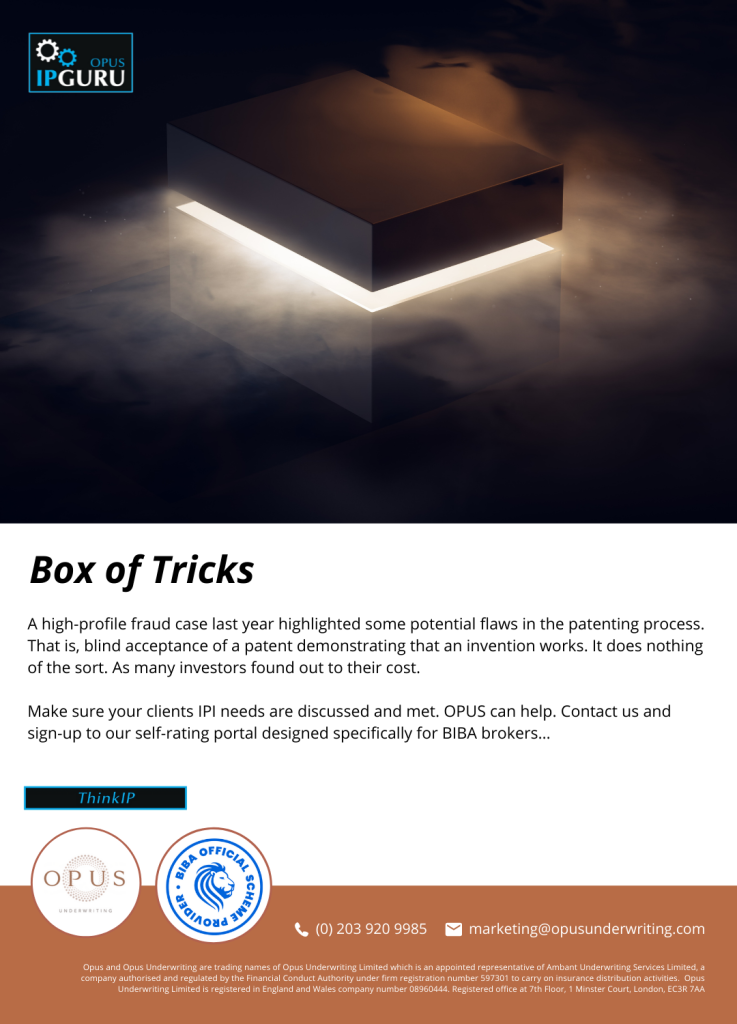What’s in the box?
Quick show of hands. How many of you thought an invention must work before you can get a patent? Thought so. You’d be wrong, as a well-publicised case in the U.S. recently laid bare.
Science fiction ambition
It’s fair to say Elizabeth Holmes was driven. She dropped out of Stanford University at 19 to work on a revolutionary machine that, it was claimed, tested a pinprick of blood for all kinds of diseases. The menu of testing available claimed a reach of 240 diseases. Efficient and much needed. The world willed her on. Her efforts and claims of efficacy attracted investment. Lots of it. To outsiders throwing money at her and her biotech business Theranos, she was the new Steve Jobs. She even wore black turtle-neck jumpers.
Like Jobs, her personal wealth hit the $billion plus stratosphere. Unlike Jobs, her medical whizzy gizmos didn’t work. And they certainly weren’t as good looking. That, although it took a while, was her undoing leading to the collapse of Theranos and a conviction for fraud. Imprisonment awaits.
To say Holmes had a ‘stretch-goal’ for her ‘magic’ testing kit is the biotech understatement of the decade. A bit like the Holy Grail turning up on a Time Team dig in Suffolk.
The sting
The con’ was fascinating.
Holmes first patented her ‘invention’ of a real-time medical detection device in 2003. It is alleged she spent five days straight, drafting the patent application wording. Dozens of follow-up patents followed culminating in a black box the size of a microwave in 2007. She called it the “Edison” and paraded it in front of (mostly not very scientific) investors. Technically, the Edison was designed to perform immunoassays which look for the presence of an antibody or antigen in blood or fluid.
It has been reported that within Theranos, those working on the box called it the “gluebot,” because it was based on a robot that dispensed glue. Inside the box was a robotic arm designed to mimic what a chemist did in a laboratory and take samples, dilute them, add antibodies and a reagent, and deliver a result. The reality was a bit different. Bits fell off the box, doors didn’t close properly, and it couldn’t regulate its own temperature.
Lovers of The IT Crowd may recall Moss giving Jen a small black box with a red light on top.
Jen: “What is it?
Moss: This Jen is the internet….
Jen: The whole internet?
Moss: Yep.”
Comedy and reality clashing neatly. For what it’s worth, the black Edison box had a green light.
And so, the con’ played out.
The role of patents
Let’s go back to basics for just a minute. What do you need to successfully obtain a patent?
UK
To be granted a patent, your invention must be all of the following:
- Something that can be made or used.
- New.
- inventive – not just a simple modification to something that already.
US
The invention must be:
- Statutory (subject matter eligible).
- New.
- Useful.
- Non-obvious.
Note: in both sets of rules the invention must be useful. If something doesn’t work, implicitly, it’s not useful and therefore cannot be patented. But here’s the rub.
The bodies tasked with issuing patents are not always able to identify non-functioning technology.
As one of the UK’s leading IP lawyers, Andrew Clay, succinctly puts it:
“…what the patenting process doesn’t test is, if it works, can it be made to work or does it have any commercial value?”
Perfect fraud storm
In the case of Holmes and Theranos, a wave was ridden. One of converging credibility in terms of the company’s clinicians, the ‘signed-up’ investor list and emerging biotech heading, albeit slowly, in the same direction. It’s quite possible the black box with the green light could have worked – in time. The fraud and misuse in the case of Holmes and her company was using all that was credible, including real patents, to offset the incredible. It worked for a while.
Edison was more patient than Holmes.
As he once said:
“I have not failed. I’ve just found 10,000 ways that won’t work.”
Murray Fairclough
Development Underwriter
OPUS Underwriting Limited
+44 (0) 203 920 9985
underwriting@opusunderwriting.com
Researched by Ben Fairclough








